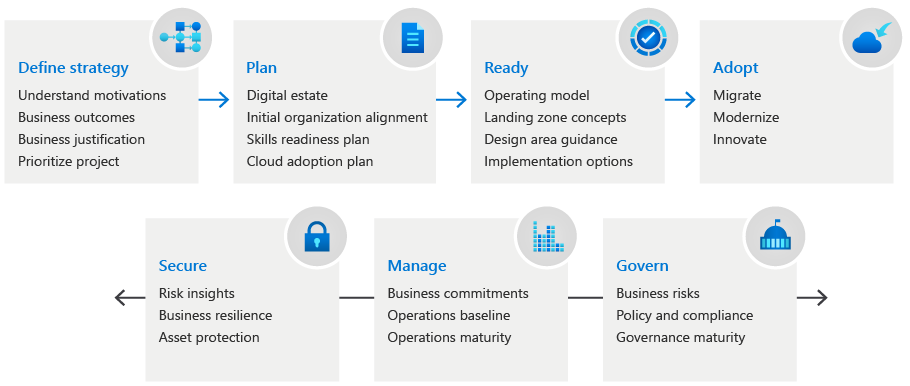Azure - Cloud Adoption Framework
Azure - Cloud Adoption Framework
Introduction
- The Azure Cloud Adoption Framework (CAF) is a set of best practices, guidelines, and tools provided by Microsoft to help organizations successfully adopt and manage cloud services.
- It’s like a roadmap that guides you through each step of moving to and operating in the cloud, ensuring you get the most out of your cloud investments.
Phases of Cloud Adoption Framework
Strategy | Define why you want to move to the cloud and what you hope to achieve. |
Plan | Make a detailed plan for how you’ll move to the cloud, including timelines and resources. |
Ready | Get your cloud environment prepared for migration by setting up the necessary infrastructure and tools. |
Migrate | Move your applications and data to the cloud. |
Innovate | Take advantage of cloud technologies to create new solutions or improve existing ones. |
Secure | Make sure your cloud environment is protected against threats and complies with security standards. |
Manage | Continuously monitor and optimize your cloud environment to keep it running smoothly. |
Govern | Set rules and policies to manage and secure your cloud environment effectively. |
Organize | Align the teams and roles supporting your organization’s cloud adoption efforts. |
Cloud Adoption Framework Lifecycle
Stages in Clodu Adoption Framework
- Strategy
Understand Motivations:- Datacenter exit, Mergers, Acquisition, Reduction in capital expenses, End of Support, Regulatory Compliance Changes, Data Sovereignty Requirements, Reduce Disruptions and Improve Stability, Reduce Environmental Impact
- Categorize motivations into Migration or Innovation categories.
Business Outcomes- Financial Performance
- Ability to respond to and drive market change quickly
- Ability to reach global customers and users
- Customer Engaement Outcomes
- Performance and Reliability Outcomes
- Sustainability Outcomes
Financial Considerations- CAPEX to OPEX
- Reduced Data Center Footprint
- Increased productivity and service delivery
Technical Considerations- Scalability
- Availability
- Security and Compliance
- Capacity Optimization
- Plan
Rationalize the digital estate- Inventory
- Quantitative Analysis
- Qualitative Analysis
- Rationalization / Incremental Rationalization
Initial organization alignment- Initial best-practice structure
- Map people to capabilities
- Evolving your organization structure
- Introduce sustainability
Define Skills Readiness Path- Microsoft Learn
- Tranings
DevOps Cloud Adoption Plan- Create your cloud adoption plan
- Use the cloud adoption plan
- Align the cloud adoption plan
- Ready
Operating Model Alignment- Compare common cloud operating models
- Define your operating model - Define how technology would support the business.
Azure Landing Zones- Design Areas - Azure billing and Microsoft Entra tenant, identity and access management, management group and subscription organization, network topology and connectivity, security, management, governance, and platform automation and DevOps.
- Platform Landing Zone - To deploy shared services
- Application Landing Zone - To host an application
- Azure landing zone accelerators - IAC implementation examples
Implementation Options- Enterprise-scale Foundation
- Azure Landing Zones Modular
- Enterprise-scale for small enterprises
- Azure Landing zones using Terraform
- Partner Landing Zones
- Migrate
ChecklistPrepare- Ready your landing zone for migration
- Prepare tools and backlog
- Select Azure regions for a migration
- Align roles and responsibilities
- Learn skills that are relevant to migration projects
Access- Classify workloads
- Evaluate workload readiness
- Architect workloads
Deploy- Deploy supporting services
- Remediate assets
- Replicate assets
- Prepare for management
- Test the migration
Release- Begin change communication
- Conduct business testing
- Complete the migration
- Optimize costs after the migration
- Conduct retrospectives
- Product migration scenarios
- AWS, IBM, Oracle, SAP
- Containers
- Windows and Linux Servers - VMWare, Hyper-V
- Remote Desktop Services
- Databases and Data Platforms
- Storage Migration
- Multitenant Migrations
- Applications - Java, Apache Tomcat, Oracle WebLogic Server
- Microsoft Access
- Innovate
Business value consensis- Understand how the innovation will help business
Build your first Minimal Viable Product(MVP)Measure of Customer Impact- Strategic Metrics
- Learning Metrics
Expand Digital Innovations- Build, Measure and Learn
- Secure
Overview- Map to concepts, frameworks, and standards - Zero Trust, The Open Group, NIST CyberSecurity Framework
- Map to roles and responsibilities - Security Leadership, Security Architect, Security Engineer
Risk Insights- Align your security risk management
- Understanding cybersecurity risk
Business Resilience- Lifecycle of Security Risk
- Before an incident
- Limit business operations impact and likelihood of security incidents
- During an incident
- Rapidly remediate active attachs
- Prioritize continuity of critical operations
- After an incident
- Rapidly restore full business operations
- Feedback loop
- Learn lessons and integration changes
- Before an incident
- Security resilience and assume breach
- Lifecycle of Security Risk
Asset Proctection- Get Secure - Apply security standards
- Stay Secure - Onging Asset Manintenance
- Manage
- Business Alignment in Cloud Environments
- Management Baseline - To establish resource consistency
- Establish operational management practices in the cloud
- Invetory and Visibility
- Operational Compliance
- Protect and Recover
- Platform Operations
- Workload Operations
- Apply design principles and advanced operations
- Platform specialization
- Workload specialization
- Improve system design
- Automate remediation
- Scale the solution
- Continuous improvement
- Monitoring, Management and Resiliency
- Govern
- Benchmark and Improve Governance
- Checklist:
- Build a cloud governance team
- Assess cloud risks
- Document cloud governance policies
- Enforce cloud governance policies
- Monitor cloud governance
This post is licensed under CC BY 4.0 by the author.
